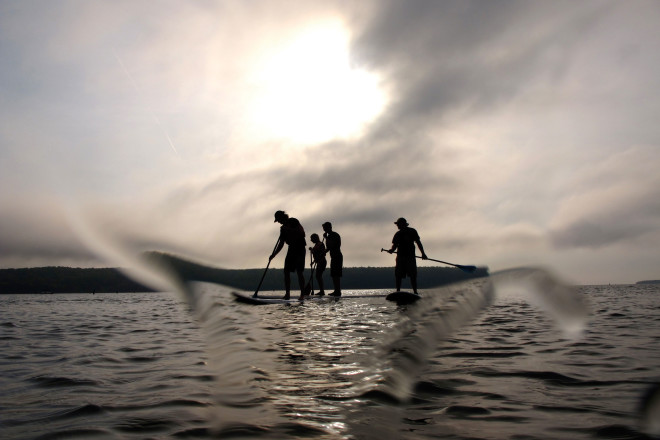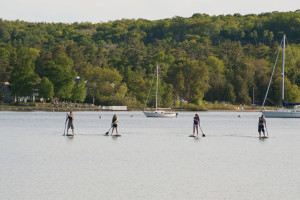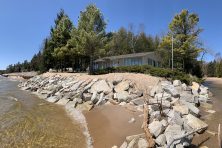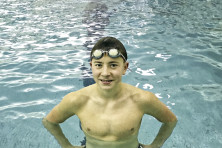Making Waves
- Share
- Tweet
- Pin
- Share

With its reputation for brats, beer and frigid football games, it’s hard to believe that the Midwest – Door County included – is gaining notoriety for stand up paddle surfing, a water sport that conjures images of bikini bods, washboard stomachs and sunny, surf culture.
While surfing can be traced back to Polynesian roots, it’s widely accepted that the popularity of modern stand up paddle surfing (SUP) has its beginnings on the island of Hawaii. Following World War II and the tourist boom to the island, thrill-seekers wanted documentation of their surf vacations, so “beach boys” would head out into the swells using outrigger paddles and their long boards to snap a few photos wave-side for the family albums.
Then, in the early 2000s, surf giants like Laird Hamilton, Dave Kalama and Rick Thomas (to name a few) used SUPs to stay in shape when the waves were less than desirable, carving out a place for SUP in locales that don’t boast ideal surf conditions, including inland lakes for flat water paddling.
Though still in its infancy on the water sport scene, SUP has exploded nevertheless. “In Matt Warshaw’s definitive Encyclopedia of Surfing, published in 2003, there is not one reference to stand up paddle surfing. Just four years later you can Google almost half a million references to it, and SUP cultures are emerging in every part of the known (and unknown) surfing world.” (standuppaddlesurf.com.au)
Chris Bank is the Midwest Regional Sales Rep for Surftech, the world’s largest manufacturer of surf and stand up paddle boards, and he has witnessed the revolution in SUP in his three years working for the company.
“Growth tripled from last year to this year, and we’re still having trouble keeping up,” he said. While SUP has anchored itself in coastal areas of the country – such as Hawaii, California and Florida – the Midwest is seen as “the number one opportunity for growth of [the flat water SUP] industry due to the size and the accessibility of water for SUP.”
Bay Shore Outdoor Store’s Program Manager Casey St. Henry began to see coverage of SUP in mainstream publications like National Geographic Adventure and Outside about five years ago, and he, too, has witnessed the growth of the sport since bringing SUP into their Sister Bay paddle shop three years ago. At last year’s Outdoor Retailer Summer Show, 30 new SUP manufacturers had hopped on the wave, hoping to capitalize.
Part of the reason for SUP’s exponential growth, especially flat water SUP, is that its audience is broad. SUP has an entry point from most niches of the water sport industry, drawing from the kayak and canoe crowd (whether expedition touring boaters or recreational paddlers) who are looking for another way to get on the water to fitness enthusiasts (such as competitive triathletes and cyclists) who are looking for a cross-training workout.
After trying SUP on a vacation in Hawaii, Patty Fess of Wheaton, Illinois and Ephraim purchased a SUP from Bay Shore Outdoor Store. “Once you get off that board you realize that you have worked out,” she said. “[But] I don’t do it for the fitness, that’s just a bonus…It’s beautiful out there. Once I get out there I could just be out there for hours. It’s peaceful and relaxing.”
Rob Morrow, a New Zealand native who now calls Door County home, learned to surf when he was 13, and he chose SUP as an inexpensive and environmentally friendly way to get out on the water with his family.
“We go over to [Anclam Beach in] Baileys Harbor if there’s surf and play in the waves,” he said. But most times he looks for a location that will be sheltered from the weather, something “nice and quiet.” Morrow exemplifies the audience St. Henry has seen drawn to SUP.
“By and large it’s families with kids,” St. Henry said. Often, parents can be seen paddling with a child perched on the front of the board if they are not yet old enough to paddle on their own. But he was also quick to not pigeonhole the SUP crowd. “That said, I did just deliver a SUP to a retired couple that bought one.”
Charlie Klein of Dorsal, a sail loft and canvas shop in Sturgeon Bay, recently added SUPs to his offerings though paddling isn’t his focus. He’s quite frank about his motivation: “I’m really excited about the possibility of people learning to windsurf and kiteboard using SUPs.”
Klein sees SUP boards as a safe way for people to learn board skills, whether paddling or being towed behind a boat. Also, it’s a way for all ages of people to get out onto the water.
“Most of my kiteboarding friends are active, adult males – a few younger females – but most of them are family people with kids,” he said.”[Kiteboarding has] been a great excuse for families to hang out on the beach building sandcastles, as dad gets out on the water.” But now, with SUP, “everyone can get out there. Any size, any age – and it’s safe.”
Bank re-iterates this theory: “If you can stand on the floor you can stand up on a paddle board. They’re that stable.”
Compared to her SUP learning experience in Hawaii, Fess said, “The board up here is like you’re riding on an aircraft carrier.”
Fess has enjoyed her SUP so much that she’s already in the market for another board – partly so that when her three, twenty-something boys come up to Door County they can race but also for her. “I would really like a board with bungee cords on the back so that I could attach a snack, allowing me to stay out longer,” she said. She uses her board as transportation to and from her home and the Ephraim Beach.
“The first time I went to the beach,” said Fess, “I pulled up to the beach and someone asked ‘Is that a Laird board? As in Laird Hamilton?’”
That name recognition of surf superstars along the shores of Green Bay enforces the idea that SUP has found a home in Door County. Morrow is pleased that SUP is finding its place not only in flat water destinations like Door County, but also within the waves of surfing.
“Just recently,” he shared, “at a lot of the big wave competitions the guys are all using stand ups now instead of jet skis [to tow into a wave], which is kinda cool because it takes it back to its origins…everyone kind of resorts back to Hawaii because of its place in surf, but really all the Polynesian Islands have been doing this for years. So it’s kind of cool that we’ve actually gone around in a circle.”
Klein feels that SUPs might actually be able to bring people in Door County full circle, too. As one of the Midwest’s premier vacation destinations (for many reasons other than brats, beer and football), “Door County has a lot of people who are here because of the water, but they’ve never been on water.”
SUP Safety
SUPs are classified as “vessels” by the U.S. Coast Guard; therefore, users must comply with federal Navigation Rules and “carriage” requirements when operating beyond the limits of a swimming, surfing or bathing area. Stand up paddlers are required to have a Personal Floatation Device (PFD, Type III) for each person, a sound signaling device (whistle), visual distress signal and navigation light (flashlight).
“I’ve never seen anyone ask a person on a SUP for [signal devices],” said St. Henry, “but I have seen them get ticketed for not wearing a PFD. It’s $110 for the ticket.” A wide array of Type III PFD’s are available, and SUP-specific styles are even hitting the market.
Another handy safety device is a board leash (a strap that connects the board to your ankle). Should you fall off, the leash will keep your SUP – literally, your biggest piece of safety equipment – from floating away.



